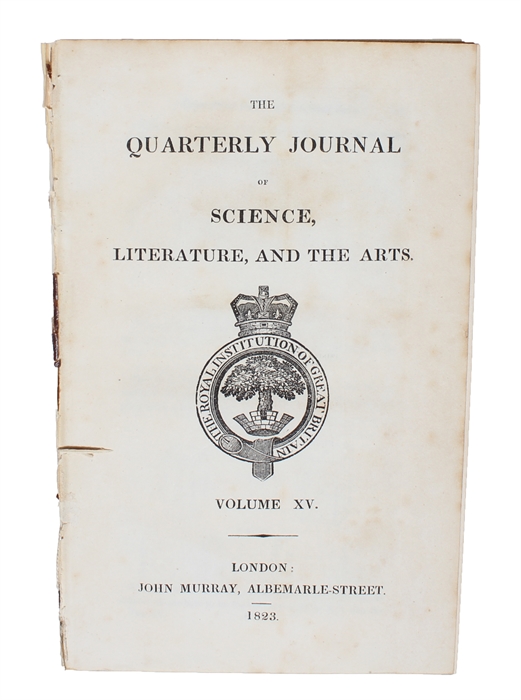THE FIRST ELECTRIC MOTOR - INTRODUCING "LINES OF FORCE" AND THE UNIVERSE OF "FIELDS"
FARADAY, MICHAEL.
On some new Electro-Magnetical Motion, and on the Theory of Magnetism. By Michael Faraday, Chemical Assistant in the Royal Institution. (+) Note on New Electro-Magnetical Motions. (+) Historical Statement respecting Electro-Magnetic Rotation. (3 Papers).
London, John Murray, (1821), 1822, 1823. Wirhout wrappers as extracted from "The Quarterly Journal of Science and the Arts. (The Royal Institution of Great Britain)", vol. XII a. XV. Half-title and title-page to vol. XII, pp. 74-96 a. pp. 416-421 and 1 engraved plate (showing Faraday's apparatus for illustrating electromagnetic rotation). Title-page to vol. XV. Pp. 288-292. The plate slightly brownspotted.
First appearance of these three papers in which Faraday records one of the most influential discoveries in physics in the 19th Century; - with these papers he is the very first to show how to CONVERT THE ELECTRICAL AND MAGNETIC FORCES INTO CONTINUAL MECHANICAL MOVEMENT, thus creating the first electric motor, using the principle of electromagnetic rotation.
In the first paper he introduced for the first time the concept of "LINE OF FORCE", hereby delineating "a picture of the universe as consisting of fields of various types, one that was more subtle, flexible, and useful than the purely mechanical picture of Galileo and Newton. The FIELD UNIVERSE was to be recognized with Maxwell half a century later and with Einstein, after an interval of another half century" (Asimov).
"Ever since Hans Christian Oersted's announcement of the discovery of electromagnetism in the summer of 1820, editors of scientific journals had been inundated with articles on the phenomenon. Theories to explain it had multiplied, and the net effect was confusion. Were all the effects reported real? Did the theories fit the facts? It was to answer these questions that Phillips turned to Faraday and asked him to review the experiments and theories of the past months and separate truth from fiction,...Faraday agreed to undertake a short historical survey...His enthusiasm was aroused in September 1821, when he turned to the investigation of the peculiar nature of the magnetic force created by an electrical current. Oersted had spoken of the "electrical conflict" surrounding the wire and had noted that "this conflict performs circles".....Yet as he experimented he saw precisely what was happening. Using a small magnetic needle to map the pattern of magnetic force, he noted that one of the poles of the needle turned in a circle as it was carried around the wire. He immediately realized that a single magnetic pole would rotate unceasingly around a current-carrying wire so long as the current flowed. He then set about devising an instrument to illustrate this effect. His paper "On some new Electro-Magnetical Motion, and on the Theory of Magnetism" appeared in the 21 October 1821 issue of the "Quarterly Journal of Science" (The paper offered). It records the first conversion of electrical into mechanical energy. It also contained the first notion of the line of force." (DSB IV, pp. 533).
Order-nr.: 43731

